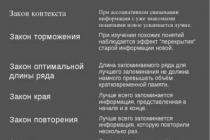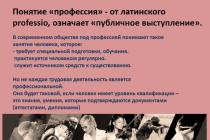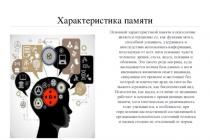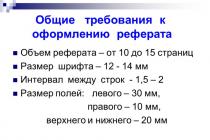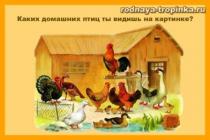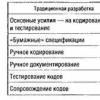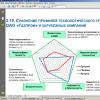Contents Introduction | Carving and painting on wood 1.1 Artistic products from birch bark 1.2 Matryoshka 1.3 Khokhloma painting | | Artistic ceramics 2.1Filimonovskaya toy 2.2 Skopinkaya ceramics 2.3 Dymkovo toy | | | Bone carving 3.1 Chukchi bone carving 3.2 Tobolsk bone carving \V Decorative painting on metal 4.1 Ural painted trays 4.2 Zhostovo trays V Lace making 5.1 Vologda lace 5.2 Kirov lace Conclusions

Folk arts and crafts is the result of creativity of many generations of craftsmen. It is unified in its artistic structure and extremely diverse in its national characteristics, which are manifested in everything from the choice of material to the interpretation of pictorial forms. The very existence of man is inseparable from nature, which provides material for housing, clothing, food, determines the rhythm of human life by the change of day and night, the alternation of seasons. A deep understanding of the material with which he works allows the craftsman to create many things as perfect works of arts and crafts. Wood and clay, stone and bone, leather and fur, straw and wicker - all these materials are organically used in various household items. This ability to use the natural qualities of the material was embodied in artistic and technical techniques. This is how the types of craft traditional for many peoples of our country have developed: carpet weaving, patterned weaving, embroidery, woodworking, etc. Introduction


Artistic products from birch bark The amazing properties of birch bark have long been considered indispensable in the life of Siberian peasants. Birch bark (the upper layer of birch bark) was used to make dishes for agricultural products. Birch bark was made to store milk. Sour cream, fish, meat. Strength, flexibility, resistance to decay - these are the main qualities of this material. The production of products from birch bark was carried out by craftsmen from many provinces of Russia. Already in the XV| | V. slotted birch bark began to be used for decoration. The material for work is birch bark, harvested in May-June, during the sap flow. At this time, it is elastic, easily removed from the tree trunk, when embossed, a deep pattern with soft edges remains on it.

There are 3 types of products made from birch bark: Braided They were made from strips of birch bark with oblique or straight weaving. The strip width could be from a minimum of 5 mm. up to 6-7 cm maximum. The sizes of the products themselves vary greatly. A camping salt shaker could be smaller than a fist, and a chest made of birch bark was not inferior in size to its fellow from the boards. The main types are the basket, pester, goiter, throat, bag, box. Plast Polotukha was made from two or three layers of birch bark, which were stitched and fastened with a pine root or a strip of birch bark. The shape is usually rectangular in plan and low in height. Sizes vary depending on the destination. Usually polutuhi were used for temporary storage, collection, processing of products. Boxes are easier to make. They were made from a single layer of birch bark, which was usually bent and fixed with a twig.

Combined The most common type of combined products is tues (skleten plus layered birch bark). Skoloten is a cylinder made of birch bark, which is removed from a birch ridge. Its dimensions can reach a cm in height, from 5 to 30 cm in diameter. It gives a cylindrical shape to the tuesu (buraku). From above, a shirt made of layered birch bark, connected in a castle. The cleavage is fastened to the shirt in an eversion way or by stitching. The bottom and lid are made of wood. The lid may have a shackle handle or a navel handle. The handle is a bow made of wood or birch bark. The shirt can be decorated with painting, embossing, carving. Simple ancient musical instruments were also made from birch bark - horns and pipes. The hunters gave each other prearranged signals, imitating the roar of an elk. Shepherds could use the horn to control the movement of the herd.

Matryoshka Matryoshka… This Russian beauty won the hearts of lovers of folk toys and beautiful souvenirs around the world. Now she is not just a folk toy, the keeper of the original Russian culture: she is also a souvenir for tourists - a commemorative doll, on the apron of which game scenes, fairy tale plots and landscapes with sights are finely drawn; she is also a precious collectible that can cost more than one hundred dollars; and young artists can experiment with her image by buying special "blanks" - "linen" - in an art salon or from the master turner himself. The first matryoshka - a chubby and plump, cheerful girl in a headscarf and a Russian folk dress - was not born in antiquity, as many believe. The figurine of the Buddhist sage Fukuruma, brought to Abramtsevo at the end of the 19th century from the island of Honshu (Japan), served as the prototype for this doll. The wooden sage had an elongated head and a good-natured face - and inspired by a charming toy (according to legend, such figures were first carved by a Russian monk who lived on the island of Honshu!), in the early 1890s, toy turner Vasily Zvezdochkin carved the first Russian nesting dolls.

From the walls of the workshop "Children's Education", founded by the philanthropist Savva Mamontov, a ruddy beautiful girl painted with gouache with a rooster in her hands came out, becoming the first nesting doll made in Russia. The sketch for its painting was created by the artist Sergey Malyutin, who personally painted the matryoshka. The first matryoshka was eight-seater - a smaller boy was placed inside a big girl, and so on - boys and girls alternated, and the smallest, "indivisible", was a nested doll - a swaddled baby. But where did this name come from - matryoshka? Some historians argue that this name comes from the beloved and common name in Rus', Masha, Manya; others - that this name comes from the female name Matryona (translated from Latin mater - mother), and still others believe that the name "matryoshka" is associated with the name of the Hindu mother goddess Matri ... At the end of the 19th century, there was a huge rise in interest in Russia Russian history, folk art, fairy tales, epics and crafts. Matryoshka quickly gained wide popularity and earned people's love. But it was expensive - and this doll, intended for children, was mainly bought by adult connoisseurs of art.

Matryoshkas are primed before painting, varnished after painting. In the nineteenth century, gouache was used to paint these toys - now unique images of nesting dolls are also created using aniline paints, tempera, and watercolors. But gouache still remains the favorite paint of artists who paint nesting dolls. First of all, the face of the toy and an apron with a picturesque image are painted, and only then - a sundress and a scarf. From the middle of the twentieth century, nesting dolls began not only to be painted, but also decorated - with mother-of-pearl plates, straws, and later with rhinestones and beads ... But the first nesting dolls did not have these decorations - and a "real", primordially Russian nesting doll is still considered a wooden painted doll, without inlays and overlays.

Khokhloma painting The name "Golden Khokhloma" very accurately defines one of the types of painted wooden utensils made in the city of Semenov and the villages of the Koverinsky district of the Nizhny Novgorod region. The golden background or golden ornament on a colored background is due to the technology of painting, which was born in the Nizhny Novgorod region at the end of the 15th | |. The village of Khokhloma, where fairs for the sale of wooden utensils and painted spoons were held, gave the name to the whole craft, now widely known in our country and abroad. During manufacture, the product goes through many stages: a semi-finished product is cut out of linden, covered with a layer of liquid clay, impregnated with linseed oil, puttied, cracks are eliminated, then covered again with oil.

There are various decorations: Horse lettering (painting on a metallic background of branches, flowers, berries); Grass (bushes and twigs written in black and red); Under the background (when the background is covered with color, her main motif of the drawing remains light with a small line cut); Kudrin (a pattern that differs in enlarged size, and all other forms resemble rounded vegetable curls).


Filimonovskaya toy Filimonovskaya toy is a Russian artistic craft, formed in the Odoevsky district of the Tula region. It got its name from the village of Filimonovo, where the last craftswomen lived in the 1960s, reviving the forgotten craft. The craft of toys originated in the middle of the X|X century among local potters. Due to the excellent quality of white clays in the Odoeva area since XV| centuries have been producing pottery, selling it at local bazaars. As in most pottery crafts, the craftsmen worked as a family, handing over products to dealers or selling them on their own in the bazaar. At the same time, men only made dishes, while women sculpted and painted toys. The appearance of the toy reflected the natural properties of the local blue clay. When drying, plastic, excessively oily clay quickly deforms, becomes covered with small cracks that have to be smoothed out with a wet hand. Thanks to this, the figurine becomes thinner and stretched, acquiring a disproportionate, but surprisingly elegant shape. After firing, products made from such clay acquire an even white color, which does not require subsequent priming.

Filimonovo craftswomen paint their toys with bright aniline paints mixed on an egg, applying them with a chicken feather. Despite the relative sparseness of their palette, the crimson, green, yellow and blue colors of the toys are bright and cheerful. Animals are traditionally painted with multi-colored stripes along the body and neck. One-color, usually green or crimson, paint is used to paint the head and chest, which are often covered with a simple lurid ornament. Filimonovo ladies and gentlemen are always dressed smartly and brightly, their hats are decorated with multi-colored stripes, and the same simple ornament is applied on the collar of the jacket, on the skirt and trousers. The clothing of the Filimonov figurines was influenced on the one hand by the urban costume, on the other hand by peasant homespun sundresses, embroidered shirts and belts. The ornament (multi-colored strokes, spots, twigs, rosettes), applied without a specific scheme, creates a catchy colorful decor.

Skopinsky ceramics Skopinsky pottery is a traditional kind of folk art in Ryazan. The industry owes its origin to clay, which occurs in large quantities in the vicinity of the town of Skopin. Pottery in places where the city of Skopin later appeared was made back in the days of Kievan Rus. In this dish they churned butter, fermented the dough, stored milk, water, kvass. 1640 is considered the year of birth of Skopino pottery. This year, the name of the first Skopinsky potter appeared in the census - Demka Kireev, son of Bernikov. The inquisitive nature of the master-experimenter was always felt in the products of the Skopinsky craft, often inventing new forms, methods of decorating and firing, sometimes borrowing them from other crafts.

Skopinsky craft has always been distinguished by a wide range of products, a riot of imagination, exceptional courage in plastic solutions, original designs of vessels, candlesticks, and sculptures. Along with laconic pottery forms, vessels were made with rich stucco, depicting various birds, fish, animals, fairy-tale and epic characters. The ornament was applied with all kinds of stamps and stacks on wet clay in the form of impressions. The nature of the ornament could be both floral and geometric, but the geometric prevailed. Products were glazed with colored glazes of various shades of brown, yellow, green, gray-blue.

Dymkovo toy Dymkovo toy is perhaps one of the oldest crafts in Russia. It arose out of love for the pottery tradition of the Vyatka lands in ancient times. The name of the toy comes from the Dymkovo settlement, today it is a district of the city of Vyatka. According to many researchers, the development of the Dymkovo clay toy is associated with the ritual spring festival “whistle dance”, which was dedicated to the sun. To take part in the celebration, one needed a clay whistle and a painted clay ball that could be tossed around. The whistles had the forms of various totemic animals: bear, goat, ram, deer, but in essence they were very simple, since their main function was magical, not decorative. Despite the ritual significance of clay whistles, there is a certain irony with which the craftsmen sculpted them. A bear, for example, could play some musical instrument, a goat could be dressed in funny pants. Such clay figurines-whistles were sculpted by women and girls long before the holiday. This work was considered exclusively female.

The technique for making a Dymkovo toy is very simple. The toy is molded by hand from local red clay mixed with river sand. Whistles are pierced with a stick. The figurine is molded in parts. Separate elements are interconnected with liquid clay. The seams are smoothed with a wet cloth. The toy is dried and fired, and then covered with whitewash (chalk diluted with milk) and painted. Each Dymkovo toy is handmade, which exists only in a single copy. Each craftswoman brings her own style and color. The craft of the Dymkovo toy has not been mass-produced to this day, which distinguishes it from other folk crafts.


Chukotka bone-carving craft Chukotka bone-carving craft is the most ancient center of walrus tusk carving and engraving. A variety of bone items were made as necessary things in the life of hunters: knives, harpoons, arrowheads. Their surface was decorated with an engraved ornament, the drawings of which have not yet been unraveled, or a sculptural image that enhances the function of the object, protects its owner from trouble, and promotes good luck in hunting. Masters perform sculptures of individual animals during the holidays and cultural groups. Single figures are quite small and rarely fit on a stand made of a block of bone. Multi-figured compositions are more often associated with their placement on the canine. On the side of the stand, as a rule, an engraved drawing is given, supplementing the story of a hunt or other event recorded in the characters of the sculpture. The combination of two types of art - sculpture and engraving - emphasizes and expands the content of the depicted event. Masters perform sculptures of individual animals during the holidays and cultural groups. Single figures are quite small and rarely fit on a stand made of a block of bone. Multi-figured compositions are more often associated with their placement on the canine. On the side of the stand, as a rule, an engraved drawing is given, supplementing the story of a hunt or other event recorded in the characters of the sculpture. The combination of two types of art - sculpture and engraving - emphasizes and expands the content of the depicted event.

Tobolsk bone carving Tobolsk bone carving dates back to the 1860s. The presence of a fossil mammoth bone, which is still found in Siberia, as well as the experience of the peoples living in the Ob River basin, prompted the Russian population to engage in artistic bone processing. They mostly depicted northern residents, busy with their daily affairs. The characters of the sculptures were carved into separate figures and then placed on a stand. With a large number of figures, trees and a plague, the entire sculptural group resembles a model, in which the story of the event was more important than the artistic and plastic organization of space.
 Ural painted trays Ural painted trays began to be made in the 18th century, during the development of metallurgical production, also associated with the production of sheet iron. Bright multi-colored painting has long been entrenched in Nizhny Tagil. Trays of various shapes were forged here: with a cut-out high side, with figured handles. A colored background was applied over the primed metal, a sweeping painting of branches with flowers or bouquets was performed with a brush, some elements were even applied with a finger. The painting was flat, rough in technique. But its color combinations, large images of plant motifs created an elegant decoration of the trays. A colored background was applied over the primed metal, a sweeping painting of branches with flowers or bouquets was performed with a brush, some elements were even applied with a finger. The painting was flat, rough in technique. But its color combinations, large images of plant motifs created an elegant decoration of the trays.
Ural painted trays Ural painted trays began to be made in the 18th century, during the development of metallurgical production, also associated with the production of sheet iron. Bright multi-colored painting has long been entrenched in Nizhny Tagil. Trays of various shapes were forged here: with a cut-out high side, with figured handles. A colored background was applied over the primed metal, a sweeping painting of branches with flowers or bouquets was performed with a brush, some elements were even applied with a finger. The painting was flat, rough in technique. But its color combinations, large images of plant motifs created an elegant decoration of the trays. A colored background was applied over the primed metal, a sweeping painting of branches with flowers or bouquets was performed with a brush, some elements were even applied with a finger. The painting was flat, rough in technique. But its color combinations, large images of plant motifs created an elegant decoration of the trays.

Zhostovo trays Not far from Moscow in a very picturesque place is the village of Zhostovo. This village has become famous not only in our country, but also abroad. And it is famous for the fact that no one better than local craftsmen can paint flowers on iron trays. The classic Zhostovo tray is large and juicy garden and wild flowers surrounded by fresh foliage, as if thrown onto a prepared background. In the first quarter of the 10th century, in the village of Zhostovo, someone decided that the technology of lacquering papier-mâché boxes could be transferred to iron: the same primer, the same lacquer, the same oil paints. It should be noted that Zhostovo was famous for blacksmiths, so the idea of the Zhostovo tray fell on fertile ground. And so the Zhostovo trays appeared, which safely exist to this day. Vologda lace The history of the appearance and development of lace is full of mysteries and contradictions. Italy and Flanders are considered the most ancient centers of lace-making. From them, all other countries of Europe learned the lace business. There is a legend that in 1725 Peter I ordered lace-makers from the Brabant monasteries to teach orphans to weave lace in the Novodevichy Convent. How long this training existed in the monastery is unknown. But what is interesting, in the samples of lace, preserved in different parts of Russia, and in the names of these laces, many old lace-makers pointed to the “draban (ie Brabant) thread”. Lacemaking, as a craft, has existed in the Vologda province since 1820. An official study (S.A. Davydova) established that during the time of serfdom, all significant landowner estates in the province had lace “factories” that supplied lace products to St. Petersburg and Moscow. (7, electronic version)

Kirov lace It is believed that Vyatka lace appeared at the beginning of the 15th | | | V. In the second half of the X|X c. A large peasant population was engaged in fishing. It was developed not only in the Kukarka region, but also in the Belaya Kholunitsa region, where there was a lace school, and orders came from St. Petersburg. In the early 1890s the crowing zemstvo school of lacemakers was opened, it contributed to the expansion of the trade. Traditional paired measured laces of the Kirov region are very diverse in the use of backings, simple nets, rhombic motifs and angular zigzag stripes are often found in them. Braids with air loops give them a special pattern. Along with geometric craftswomen, floral ornaments are often built on contrasting combinations of a rare lattice with dense lining and linen.

Conclusions Each of the arts and crafts has the richest opportunities for creating things that have significant aesthetic values, which is proved both by the experience of the masters of previous generations and the works of the masters of our time. This is confirmed by the collections of museums, in which the products of folk craftsmen are kept on a par with works of painting, sculpture, and graphics. It is impossible to overestimate the importance of the storehouse of folk traditions for the spiritual education and development of the younger generation. From childhood, we are obliged to acquaint children with folk traditions and culture so that future generations can preserve and increase everything that has been accumulated over the centuries, collected bit by bit.

Lesson 17. Chips. Painting on bast and wood. Embossing and carving on birch bark.
The goals of the teacher
To form knowledge about the artistic images of folklore; to form the ability to work with a template, scissors in the process of making a bird-sun; to form activity in children in the process of creative activity; to cultivate accuracy in the performance of practical work and interest in the historical past of their people.
Lesson type
Lesson image.
Planned
educational
results
Personal: show aesthetic needs, discuss and analyze the work performed. Express your personal attitude, aesthetically evaluate the products of the Russian North
cognitive: to distinguish and name the characteristic features of the Mezen wooden painting, its pronounced graphic ornamentation. Create a painting composition in the tradition of the Mezen masters.
Communicative: be able to listen and engage in dialogue, participate in a collective discussion of problems, express their thoughts in accordance with the tasks.
Methods and forms
learning
Explanatory and illustrative, research, game; frontal, individual, group.
Educational Resources
Fine arts textbook Grade 5
Equipment
Textbook, pencil, album, paints, brushes, water container.
Visual and demonstration material
Photographs of works.
Basic concepts and terms
Chips, bast, birch bark.
Organizational structure (script) of the lesson
Stages
lesson
Educational and developmental
Components, tasks and exercises
Teacher activity
Implemented
activity
students
Forms
cooperation organizations
Formed
skills
(universal learning activities)
intermediate control
I. Organizational
moment
Preparing students for learning new material. Conversation with elements of discussion
Greetings. (Hello guys!)
Checking the attendance of students according to the journal.
Checking readiness for the lesson (availability of teaching aids and stationery).
Setting goals and production tasks for students.
What do you think is amazing about our class today? (birds). Have we met with this image in previous lessons? (in embroidery, carving). Today we will get acquainted with a new craft, with the history of its origin, and the technique of execution.
Share their impressions
Front work
Cognitive: compare objects.
Regulatory:
put forward versions (about what they saw).
Communicative: correct their opinion (in accordance with the opinion of their comrades).
Personal: are aware of their interests (what it means to learn to see)
Continuation of the table.
II. Learning new material
Game.
Explanatory-illustrative
Tell me, what is the main material in peasant life? Tree and birch. From birch bark they make dishes, tuesa and beetroot. (Demonstrate products) They were used to pick berries and mushrooms. Boxes and bottles for food storage. In the Russian North and in the Urals, and in other parts of Russia, birch bark utensils were decorated with delicate carvings, of the finest workmanship. Let's get acquainted with the Mezen painting. It originated in the villages on the Mezen River. Consider the work with this painting, the images are very conditional. But despite the seeming ineptness and naivete, the painting strikes with its elegant painting. In the ornament, the artist uses conventional signs that are well known to us. Let's remember them, what do they mean? (children's answers). Caskets, boxes, saucers, caskets were decorated with embossing and notching. Elegant patterns delight the eye with their beauty. And they are also made by village craftsmen from thin, light chips of fabulous birds. A pinched bird, or a bird - the sun, appeared on the shores of the White Sea in the Arkhangelsk region. In the old days, such birds hung under the ceiling in almost every house of the peoples of the North - they protected peace, protected from invasions.
The image of a bird is often found among the Russian people and in fairy tales, and epics, and parables.
Today, this bird can be found in many homes. She is a tribute to the ancestors, their faith, and just a beautiful thing that decorates the home, makes it cozy.
Fizminutka.
They answer the questions asked.
Individual
alnaya,
group work
Cognitive: learn new things
Regulatory:
work according to the plan, referring to the goal.
Communicative: organize group work.
Personal:
learn new social roles
The end of the table.
III. Creative practical activity
Research
Practical work of students
Using a template, the body of the bird is transferred to paper;
The bird is decorated with multi-colored drawings;
The tail and crest are painted in northern traditions.
Doing creative work.
Individual work
Regulatory: planning activities in a learning situation
IV. Lesson results.
Reflection
Conversation
in the form of "question - answer"
Reflection: What is bast, wood chips, birch bark? Where did this type of industry originate?
D.z. Prepare for the test The role of folk art crafts in modern life.
Answer
to questions
in the form of a dialogue with the teacher. View, discussion
and evaluation of the work done.
Communicative: express their opinion in a dialogue.

Painting on wood, bast and birch bark was developed in the Vologda land no less than carving.
Of particular interest is the artistic painting of folk household items, which occupied an important place in the decorative art of the peoples of the North. Painting on wood was widely used on the Mezen and along the Northern Dvina, along the Sukhona and its tributaries, the South and Luza.
Bast products



Mezen painting
Along the Mezen River, which flows through the territory of the Komi ASSR and the Arkhangelsk region and flows into the White Sea, peoples have lived since ancient times, accustomed to humble the harsh nature of the majestic and wild nature. The forest shared fur-bearing animals and birds with people, a full-flowing river gave fish. Horses and deer were the best helpers of man in crafts and agriculture. All these images could not but find a place in the Mezen painting


Applied technique: drop, tendril, stroke, leaf. Main
the motif is a geometric ornament - solar signs, crosses,
diamonds.


Practical work:
paint the shape of the tues with Mezen painting
LESSON TOPIC: Wood chips. Painting on bast and wood. Embossing and carving on birch bark.
5 B, C, D - 12/14/16
5 A class -15.12.16
Teacher: Menshikova D.N.
Lesson type: combined
Personal UUD: express aesthetic needs, discuss and analyze the work performed. Express your personal attitude, aesthetically evaluate the products of the Russian North
Cognitive UUD: distinguish and name the characteristic features of the Mezen wooden painting, its pronounced graphic ornamentation. Create a painting composition in the tradition of the Mezen masters.
Communicative UUD : be able to listen and enter into a dialogue, participate in a collective discussion of problems, express their thoughts in accordance with the tasks
Equipment:
Presentation
Visualization of painting on wood
Templates, colored paper, landscape sheet, felt-tip pens, scissors, glue, brushes.
Tasks: 1. Contribute to the formation of knowledge about folk art craft - Mezen painting;
2. Formation of knowledge about the methods of stylization of forms in the ornament;
3. Contribute to the formation of skills to work graphically; improving the skills of graphic painting based on the Mezen painting;
4. Contribute to the formation of the development of constructiveness, expediency, variability of thinking.
Lesson summary
Org. Moment Greetings, checking readiness for the lesson.
1. Motivation
What is the image in our class today? (birds).slide 1. Have we met with this image in previous lessons? (in embroidery, carving). What does the bird symbolize? (spring and heat). Do you want to know what kind of wonderful bird this is?
2. Update
What do you think this bird is made of? (From wood). Boys, do you have a lot of chips left in technology lessons when working with wood? Do you use them in production? (answers) And this bird is not made of solid wood, but of chips, and they are calledwood chips
And what is this bird decorated with? (painted). And what kind of wood painting loan do we already have? (Gorodets, Khokhloma). Slide 2.
3. Identification of difficulty: And how else do you decorate wooden products besides painting? (carving, embossing).
Guys, can tree bark be used in the manufacture of utensils? (Yes). Birch bark and bast have long been used to make various utensils. Today in the lesson we will learn what it is and how this material is used. And let's get acquainted with the latest folk painting.
Slide 3. Topic voicing:Chips. Painting on bast and wood. Embossing and carving on birch bark.
4. Setting goals and objectives.
Slide 4. Purpose: - to form knowledge about artfishingRussia;
To teach how to make a bird-sun, to use elements of the Mezen painting to decorate it.
5. Primary assimilation of new knowledge.
Today we will get acquainted with a new craft, with its history of origin, and the technique of execution. What is birch bark, bast and wood chips and Mezen painting!? You will now give us commands. (Working with information).
Teams are voiced by definition and talk about products from the material:
Slide 5. Team 1: Beresta
They decorated such utensils with openwork carvings, the finest work. Caskets, boxes, saucers, caskets were decorated with embossing and notching. Elegant patterns delight the eye with their beauty.
Slide 6. Team 2: Chips
Today we will learn how to make such a bird, only from cardboard and paper.
Slide 7. Team 3: Lub
Products were also decorated with paintings, but of a special kind.
Slide 8. Team 4: Mezen painting
Today we have to complete the bird-sun, what kind of bird the student will tell us.
Slide 9. Student's story.
We will make a bird-sun out of cardboard and paper and decorate it with elements of the Mezen painting.
But before we get to work, let's warm up and remember how birds love to relax ...
6. Physical Minute. Slide 10
Birds jump, fly (Children jump)
Little birds are collected. ("peck")
The feathers have been cleaned
Beaks cleaned (depict)
Birds fly, sing (waving their hands)
The grains are pecking (bending down)
They flew further
And they sat down in place (fly away, sit down)
7. Initial check of understanding
What colors are typical for Mezen painting? (Red Black)slide 11, 12
And what images? (simple and conditional)
8. Practical work of students
What do we need to make our bird?
Material: torso template, colored paper, scissors, glue, felt-tip pens and pencils.
slide 13
Plan:
1. Decorate the body with patterns;
2. Glue the parts of the body by inserting the tape;
3. Paint wings, tail, (tuft) with an ornament along the edge;
4. Make an accordion from the painted parts of the bird;
5. Insert the wings and tail into the cuts, straighten;
6. Fasten the edges of the tail with glue.
9. Rate yourself and a friend. Slide 14
Achieving goals Slide 15 What have we achieved?
10. Reflection Slide 16
And now I want you to give me your regards. Circle your palms on the back of the diary, and sign your continuation of the phrase on each finger.
DZ: Repeat all folk art crafts in modern life.
Summary of the lesson. Slide 17 Workplace cleaning.
Chips. Painting on bast and wood. Birch bark embossing and carving Topic 13
Did the job
Shchebunyaev Vladislav Viktorovich
Drawing teacher MBOU "Sholokhov Gymnasium" village Veshenskaya
The main material in peasant life is wood and birch bark.
- The main material in peasant life is wood and birch bark.
- They make dishes from birch bark - tuesa and beetroot for storing food, drink, wild berries.
- From the bast, i.e. a layer of wood under the bark, boxes, bread bins, buns for berries and mushrooms.
- From thin, light chips, craftsmen make fabulous birds with a magnificent, like a fan, tail and wings.
- A bird suspended from the ceiling spins even from a light breeze.
- The master received chips from pine chocks. We tried to make the chips thin.
- Then they laid one chip after another, catching them with curly edges. It turned out an elegant tail and wings.
- The painting originated on the Mezen River.
- This is the work of the famous master Ivan Fatyanov.
- Mezen craftsmen also decorated spinning wheels with their patterns.
- On a golden background, a red-brown color usually prevails, complemented by a clear graphic pattern.
- Mezen painting differs from other traditional paintings in its color restraint and refined graphics.
- For this, masters use metal pens with ink, special pens - isographs or thin brushes.
- Make a sketch of the dishes in which the Mezen painting is presented. QUESTIONS:
- What folk art crafts of Russia do you know?
- Where do folk craftsmen get images, plots, ornaments?
- How do you understand the expression "sense of material"?

